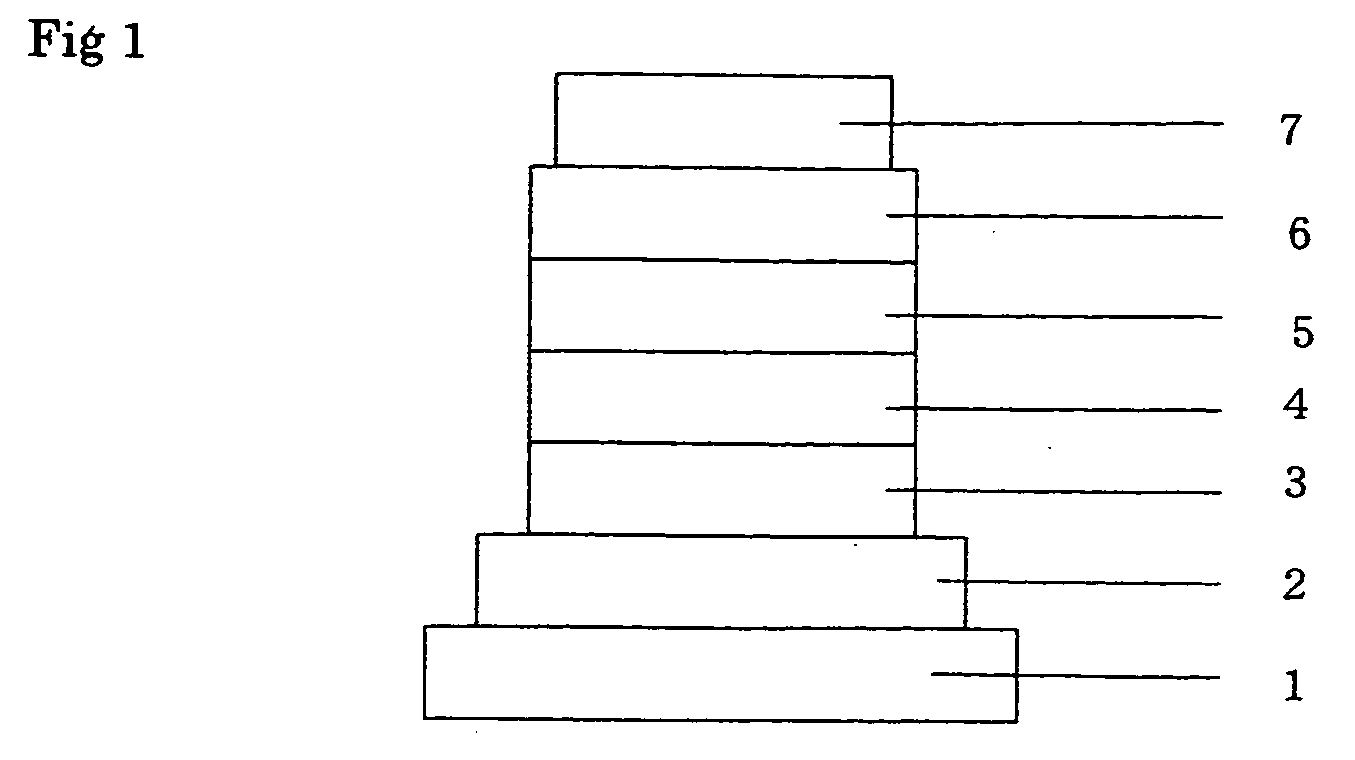Heterocyclic compound and organic electroluminescent device using the same
a technology of organic electroluminescent devices and compound, which is applied in the direction of discharge tube luminescnet screens, other domestic articles, organic chemistry, etc., can solve the problems of deterioration of shape, lack of sufficient driving stability for practical use, and insufficient durability of compound, so as to improve the luminous efficiency of the device, secure the driving stability of the device, and high efficiency
- Summary
- Abstract
- Description
- Claims
- Application Information
AI Technical Summary
Benefits of technology
Problems solved by technology
Method used
Image
Examples
synthetic example 1
Synthesis of 2,7-dinitrodibenzodioxin
[0065]To 1600 ml of acetic acid was added 60 g (0.326 mole) of dibenzodioxin and 280 ml of fuming nitric acid was added in drops to the mixture over a period of 1 hour with stirring at room temperature. After completion of the dropwise addition, the mixture was stirred further for 2 hours and a precipitate was recovered by filtration. The precipitate was reslurried with methanol and dried under reduced pressure to give 85.7 g (0.313 mole, 96.0% yield) of 2,7-dinitrodibenzodioxin. The product thus obtained showed a purity of 96.5 area % (HPLC, 254 nm).
synthetic example 2
Synthesis of 2,7-diaminodibenzodioxin
[0066]To a mixture of 1200 ml of anisole and 800 ml of THF were added 69.7 g (0.254 mole) of 2,7-dinitrodibenzodioxin and 22.2 g of 10% palladium / carbon and hydrogen gas was passed through the mixture with stirring at room temperature for 8 hours. The 10% palladium / carbon was removed by filtration, then a precipitate containing the 10% palladium / carbon was collected by filtration, and the precipitate was rinsed with THF. The rinsings were concentrated and dried under reduced pressure to give 25.0 g (0.117 mole, 46.0% yield) of 2,7-diaminodibenzodioxin. The product showed a purity of 98.1% (HPLC, 254 nm).
synthetic example 3
Synthesis of 2,7-bis(acetylamino)dibenzodioxin
[0067]To a mixture of 900 ml of toluene and 900 ml of THF were added 50.0 g (0.233 mole) of 2,7-diaminodibenzodioxin and 55.3 g (0.699 mole) of pyridine and to the resulting mixture was added 59.5 g (0.583 mole) of acetic anhydride in drops over a period of 10 minutes at room temperature with stirring. After the dropwise addition, the mixture was stirred overnight and a precipitate was recovered by filtration. The precipitate was reslurried with toluene (250 mix 2) and dried under reduced pressure to give 57.0 g (0.191 mole, 82.0% yield) of 2,7-bis(acetylamino)dibenzodioxin. The product showed a purity of 99.3 area % (HPLC, 254 nm).
PUM
| Property | Measurement | Unit |
|---|---|---|
| temperature | aaaaa | aaaaa |
| temperature | aaaaa | aaaaa |
| pH | aaaaa | aaaaa |
Abstract
Description
Claims
Application Information
 Login to View More
Login to View More - R&D
- Intellectual Property
- Life Sciences
- Materials
- Tech Scout
- Unparalleled Data Quality
- Higher Quality Content
- 60% Fewer Hallucinations
Browse by: Latest US Patents, China's latest patents, Technical Efficacy Thesaurus, Application Domain, Technology Topic, Popular Technical Reports.
© 2025 PatSnap. All rights reserved.Legal|Privacy policy|Modern Slavery Act Transparency Statement|Sitemap|About US| Contact US: help@patsnap.com



